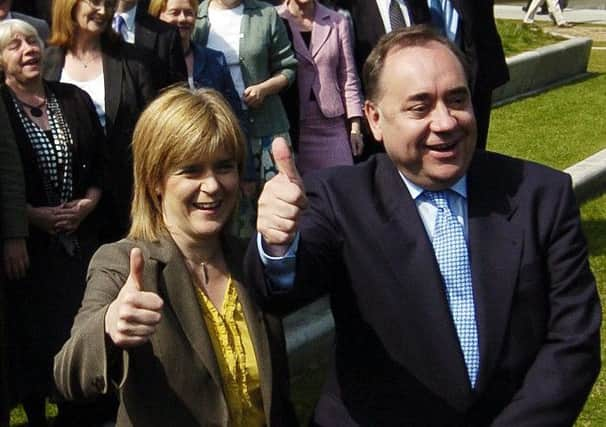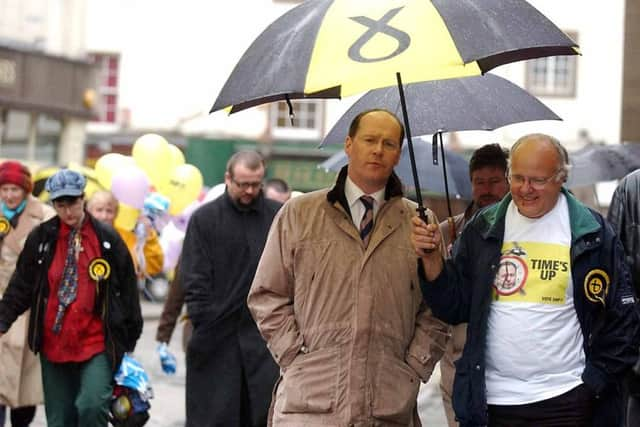Scottish Parliament at 20: Why devolution failed to ‘kill nationalism stone dead’


The two decades of devolution have been marked by a tectonic shift in the political landscape of Scotland. Labour’s hegemony as the home for the majority of Scots seemed fortified after it delivered devolution following Tony Blair’s landslide UK election victory of 1997.
But it was the SNP which was to maximise the political opportunities presented by the return of the Scottish Parliament after three centuries in abeyance. Within a decade of Holyrood opening, the historic, first SNP Government had seized power and 2014 saw the country brought to the cusp of independence before Scots decided to stay in the UK in the referendum that year.
Advertisement
Hide AdAdvertisement
Hide AdBut the Nationalists have nonetheless established themselves as the natural party of working class Scotland, while Labour has sunk to a once unthinkable third place behind the Conservatives.


Labour had won every Scottish election since 1959 by time of the inaugural Holyrood election of 1999. And it was a widely anticipated victory for Donald Dewar, as Labour emerged as the largest single party in that May’s election with 56 seats to the SNP’s 35.
A coalition with the Liberal Democrats in the first two Parliaments saw the introduction of landmark legislation such as free personal care for the elderly, land reform with its “right to roam”, as well as the abolition of university tuition fees and the smoking ban.
Dewar’s premature death saw the emergence of Jack McConnell as the party’s new figurehead in Scotland, via Henry McLeish’s year-long spell as First Minister. And although McConnell held onto power in 2003, the loss of six seats marked stirs of growing disenchantment with the party which had delivered devolution. However, the SNP’s miserable campaign saw eight seats lost, a result which was to cost John Swinney the party leadership.


The most striking difference that Holyrood provided almost immediately was a new political sphere and platform for this new generation of devolved politicians. Broadcasters and newspapers hired entire political reporting teams to shine a spotlight on the daily activities of this new Parliament.
It played into the hands of the SNP, despite its early electoral disappointments. The Nationalists suddenly had a profile which it could never dream of at Westminster, where the first past the post unusually saw it squeezed out and consigned to just a handful of MPs.
For Labour, the additional spotlight could often be awkward. Much of its problems lay in a perception of the party’s relationship with Westminster. Although harmonious, it was often depicted as subservient by the Nationalists who insisted it could not be trusted to stand up for Scotland’s best interest.
It coincided with a period which saw Gordon Brown ensconced at the heart of the New Labour Government as Tony Blair’s chancellor, while John Reid, George Robertson and Alistair Darling were among a host of other leading Scots Labour politicians in senior Government roles. The perception was that the cream of the party’s Scottish talent went to Westminster, while the rest ended up at Holyrood.
Advertisement
Hide AdAdvertisement
Hide AdThis only intensified when Alex Salmond returned as SNP leader in 2004. He entered the contest to replace Swinney when it seemed his preferred candidate – Nicola Sturgeon – was poised to lose to Roseanna Cunningham. Salmond had been a key agitator of the 79 Group of the SNP which had sought to shift the party to the left and replace Labour as the party of working class Scotland. This was the key to making electoral inroads in Scotland, instead of the catch-all approach of the Nationalists which had once seen them branded the “tartan Tories.”
Salmond’s victory in the 2007 Holyrood election, by just one seat from Labour, changed everything. Although the margin of victory was too narrow for an independence referendum to be on the agenda, the new administration did launch its National Conversation on the future of the constitutional set-up for the country which sought to examine powers for Holyrood and even independence. Salmond’s garrulous approach even appeared to have provoked a emboldened stance from, Wendy Alexander, Labour’s new leader at Holyrood, who infamously retorted “Bring it On” when asked about the prospect of a second referendum.
The prospect of Labour backing such a vote was later ruled out by Brown. Alexander instead sought to steal a march on the constitutional issue by setting up the Calman Commission on the tenth anniversary of devolution to look at more powers for Holyrood. New controls over areas like income tax, landfill tax, airgun control and borrowing powers were eventually devolved.
But that first SNP administration was to be marked by a new fractious relationship with Westminster marked by suspicion, distrust and frequent public spats. Barely a month after taking office as First Minister, Salmond suddenly announced he was to make an emergency statement one Thursday afternoon on UK relations with Libya. Without any notice to Westminster, he went on to lift the lid on the so-called “Deal in the Desert” which could have allowed the Lockerbie bomber Abdelbaset al-Megrahi to be transferred to prison in Libya, in exchange for UK firms securing lucrative oil rights.
The new Nationalist administration at Holyrood was laying down a marker that things were going to be different. Gunboat diplomacy was the new order of the day in cross-border relations.
And despite having to govern as a minority administration, a tranche of popular policies were passed, including the council tax freeze, scrapping of bridge tolls and axing NHS prescriptions. For all the trepidation many Scots may have harboured about the strife and division which could be ushered in with an SNP Government, the sky didn’t actually fall in. The party was able to govern capably and foster a narrative that they were ready to fight Scotland’s corner. This, coupled with a disastrous Labour campaign, resulted in an unprecedented SNP majority in the 2011 election.
The former Labour defence Secretary George (now Lord) Robertson had once famously claimed devolution would “kill nationalism stone dead.” Instead Scotland was hurtling towards a referendum on independence in 2014. And it was a campaign which was to dominate much of the fourth Parliament. It would firmly establish Holyrood as the centre of political gravity for Scotland. As polls narrowed in the final weeks, it seemed that the Yes campaign may be poised for a dramatic victory. In the end, Scots voted by 55 per cent to 45 per cent to remain in the UK.
The SNP may have lost the referendum, but its popularity among the Scottish electorate was undiminished. It’s membership soared from just under 15,000 in the aftermath of the referendum to more than 120,000 in the years following. Labour on other hand was to suffer over its involvement in the Better Together campaign, alongside the Tories and Liberal Democrats, by now coalition partners in Government at Westminster. The immediate upshot of the referendum was to leave Scottish politics split down constitutional lines. But while the SNP could rely on the lion’s share of the 45 per cent which backed independence, the others were squabbling over a falling pro-union constituency.
Advertisement
Hide AdAdvertisement
Hide AdIt saw the SNP capitalise in spectacular fashion in the 2015 Westminster election as the party swept to 56 of Scotland’s 59 seats. Labour was left with just one seat – down from 41. Worse was to follow for Labour in the Scottish Parliament election of 2016 when the unthinkable happened and the party was beaten into third place by the Conservatives. The Tories, newly invigorated under its young leader Ruth Davidson campaigned unashamedly to protect Scotland’s place in the UK.
The Tories’ 31 seats were seven up on Labour. The SNP returned a commanding 63 seats, just two short of a majority, while the five Green MSPs ensured another pro-independence majority at Holyrood. The Brexit vote later that year ensured the constitutional debate remained at the heart of the political landscape in Scotland.
And despite a setback in the 2017 elections with the loss of 21 seats, Nicola Sturgeon has now fired the starting gun on second referendum, ensuring constitutional politics continue to dominate the devolved political landscape for years to come.
